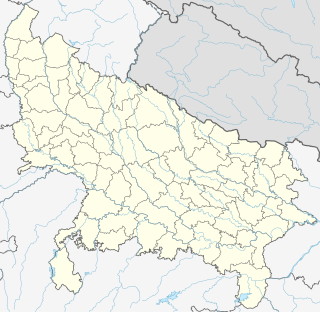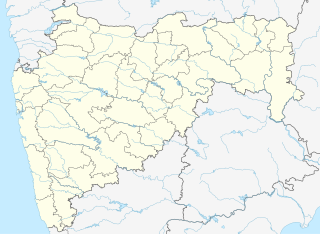
Raichur District is an administrative district in the Indian state of Karnataka. It is located in the northeast part of the state and is bounded by Yadgir district in the north, Bijapur and Bagalkot district in the northwest, Koppal district in the west, Bellary district in the south, Jogulamba Gadwal district of Telangana and Kurnool district of Andhra Pradesh in the east.

Bronze Age swords appeared from around the 17th century BC, in the Black Sea region and the Aegean, as a further development of the dagger. They were replaced by iron swords during the early part of the 1st millennium BC.

The Ochre Coloured Pottery culture (OCP) is a Bronze Age culture of the Indo-Gangetic Plain "generally dated 2000–1500 BCE," extending from eastern Punjab to northeastern Rajasthan and western Uttar Pradesh.

Bijnor is a city and a municipal board in Bijnor district in the state of Uttar Pradesh, India. To boost its development, there is demand for the inclusion of Bijnor in the Delhi NCR.
Frank Raymond Allchin FBA with his wife, Bridget Allchin FSA (1927–2017), represent one of the most influential British partnerships in the post-Independence study of South Asian archaeology. Producing a large body of scholarship ranging from archaeological excavations, ethnoarchaeology as well as epigraphy and linguistics, the Allchins made their work and that of others highly accessible through a series of sole, joint and edited publications. Seminal works include The Birth of Indian Civilisation (1968), which was later superseded only by their books The Rise of Indian Civilisation in India and Pakistan (1982) and The Archaeology of Early Historic South Asia (1995).

The khanda is a double-edge straight sword originating from the Indian subcontinent. It is often featured in religious iconography, theatre and art depicting the ancient history of India. It is a common weapon in Indian martial arts. Khanda often appears in the Sikh, Jain, Buddhist and Hindu scriptures and art.

Copper Hoard Culture describes find-complexes which mainly occur in the western Ganges-Yamuna doab in the northern part of the Indian subcontinent. They occur mostly in hoards large and small, and are dated to the first half of the 2nd millennium BCE, although very few derive from controlled and dateable excavation contexts. The copper hoards are associated with the Ochre Coloured Pottery (OCP), which is closely associated with the Late Harappan phase of the IVC. Associations with the Indo-Aryan migrants of the second millennium BCE have also been proposed, though association with the Vedic Aryans is problematic, since the hoards are found east of the territory of the Vedic Aryans.

Chandravalli is an archaeological site located in the Chitradurga district of the state of Karnataka, India. The region is a valley formed by three hills, Chitradurga, Kirabanakallu and Jolagudda. It is a semi-arid region with scrub vegetation with a stream running through it. Excavations at Chandravalli have revealed earthen pots, painted bowls and coins of Indian dynasties like Vijayanagar, Satavahana and Hoysalas as well as denarii of Roman emperor Augustus Caesar and a coin of the Chinese Han dynasty Emperor Wu Ti belonging to 2nd Century BC.
Brahmagiri is an archaeological site located in the Chitradurga district of the state of Karnataka, India. Legend has it that this is the site where sage Gautama Maharishi and his wife Ahalya lived. He was one among seven noted Hindu saints. This site was first explored by Benjamin L. Rice in 1891, who discovered rock edicts of Emperor Ashoka here. These rock edicts indicated that the locality was termed as Isila and denoted the southernmost extent of the Mauryan empire. The Brahmagiri site is a granite outcrop elevated about 180 m. above the surrounding plains and measures around 500 m east-west and 100 m north-south. It is well known for the large number of megalithic monuments that have been found here. The earliest settlement found here has been dated to at least the 2nd millennium BC.

Maski is a town and an archaeological site in the Raichur district of the state of Karnataka, India. It lies on the bank of the Maski river which is a tributary of the Tungabhadra. Maski derives its name from Mahasangha or Masangi. The site came into prominence with the discovery of a minor rock edict of Emperor Ashoka by C. Beadon in 1915. It was the first edict of Emperor Ashoka that contained the name Ashoka in it instead of the earlier edicts that referred him as Devanampiye piyadasi. This edict was important to conclude that many edicts found earlier in the Indian sub-continent in the name of Devanampiye piyadasi, all belonged to Emperor Ashoka. The edict is etched on a rock-face of Durgada-gudda, one of the gneissic outcrops that are present in the site.
Bridget Allchin was an archaeologist who specialised in South Asian archaeology. She published many works, some co-authored with her husband, Raymond Allchin (1923–2010).

Alamgirpur is an archaeological site of the Indus Valley Civilization that thrived along Yamuna River from the Harappan-Bara period, located in Meerut district, Uttar Pradesh, India. It is the easternmost site of the civilization.

Mundigak is an archaeological site in Kandahar province in Afghanistan. During the Bronze Age, it was a center of the Helmand culture. It is situated approximately 55 km (34 mi) northwest of Kandahar near Shāh Maqsūd, on the upper drainage of the Kushk-i Nakhud River.

Daimabad is a deserted village and an archaeological site on the left bank of the Pravara River, a tributary of the Godavari River in Shrirampur taluka in Ahmednagar district of Maharashtra state in India. This site was discovered by B. P. Bopardikar in 1958. It has been excavated three times so far by the Archaeological Survey of India teams. The first excavation in 1958-59 was carried out under the direction of M. N. Deshpande. The second excavation in 1974-75 was led by S. R. Rao. Finally, the excavations between 1975-76 and 1978-79 were carried out under the direction of S. A. Sali. Discoveries at Daimabad suggest that Late Harappan culture extended into the Deccan Plateau in India. Daimabad is famous for the recovery of many bronze goods, some of which were influenced by the Harappan culture.
Amalananda Ghosh was an Indian archaeologist, the author and editor of numerous works on India's ancient civilizations, and the organizer and director of archaeological expeditions during the mid-1900s.

The Sinauli excavation site is an archaeological site located in Sinauli, western Uttar Pradesh, India, at the Ganga-Yamuna Doab. The site gained attention for its Bronze Age solid-disk wheel carts, found in 2018, which were interpreted by some as horse-pulled "chariots".

Jognakhera is an archaeological site belonging to late Harappan phase of Indus Valley Civilisation. Jogankhera is located in Kurukshetra District, Haryana, India.

The stone circles of Junapani are prehistoric megalithic circles in Junapani, near Nagpur in the Indian state of Maharashtra. There are about 300 such stone circles noted around Junapani. They were first excavated by J. H. Rivett-Carnac in 1879, yielding a variety of iron objects including daggers, flat axes with cross-ring fasteners, hoes, rings, bracelets, horse bits, chisels with long blades, and pointed tongs, possibly covered with a wooden handle. There is also evidence of black and red pottery, such as bowls featuring linear paintings in black. The burial sites were characterized by cairns. About 150 stone circles have been studied and documented. A notable feature is the cup-marked stones in the circles which seem to suggest an astronomical significance. This aspect has been discerned from the fact that the cup-marked stones are fixed at specific locations denoting specific directions.
Dabarkot, or Dabar Kot, is a tell site of the Indus Civilization in Balochistan, Pakistan. The large city was once a trading post dating back to fifth millennium BC. Various artifacts and figurines excavated from the area show a Harappan connection of the site. The Dabarkot mound is 500 yards in diameter showing the settlement was large in size and of considerable significance. Excavations from the site recovered various artifacts including stone beads, copper pieces, a gold pin, sheet metal, and large mud bricks.













